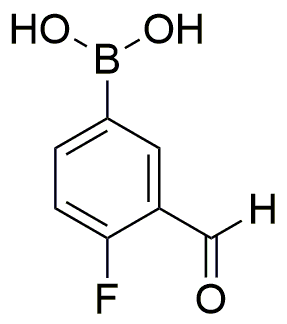4-Fluoro-3-formylphenylboronic acid is widely utilized in research focused on:
- Organic Synthesis: This compound serves as a key intermediate in the synthesis of various pharmaceuticals and agrochemicals, allowing researchers to create complex molecules efficiently.
- Drug Development: Its unique reactivity makes it valuable in the development of targeted therapies, particularly in oncology, where precision is crucial for effective treatment.
- Materials Science: Used in the preparation of functionalized materials, it contributes to the development of advanced polymers and nanomaterials with enhanced properties.
- Bioconjugation: This chemical facilitates the attachment of biomolecules in the creation of bioconjugates, which are essential for drug delivery systems and diagnostic applications.
- Analytical Chemistry: It aids in the development of sensors and analytical methods, improving detection limits and specificity for various analytes in complex samples.
Informations générales
Propriétés
Sécurité et réglementation
Applications
4-Fluoro-3-formylphenylboronic acid is widely utilized in research focused on:
- Organic Synthesis: This compound serves as a key intermediate in the synthesis of various pharmaceuticals and agrochemicals, allowing researchers to create complex molecules efficiently.
- Drug Development: Its unique reactivity makes it valuable in the development of targeted therapies, particularly in oncology, where precision is crucial for effective treatment.
- Materials Science: Used in the preparation of functionalized materials, it contributes to the development of advanced polymers and nanomaterials with enhanced properties.
- Bioconjugation: This chemical facilitates the attachment of biomolecules in the creation of bioconjugates, which are essential for drug delivery systems and diagnostic applications.
- Analytical Chemistry: It aids in the development of sensors and analytical methods, improving detection limits and specificity for various analytes in complex samples.
Documents
Fiches de données de sécurité (FDS)
La FDS fournit des informations de sécurité complètes sur la manipulation, le stockage et l’élimination du produit.
Spécifications du produit (PS)
Le PS fournit une description complète des propriétés du produit, notamment sa composition chimique, son état physique, sa pureté et les exigences de stockage. Il détaille également les plages de qualité acceptables et les applications prévues du produit.
Certificats d'analyse (COA)
Recherchez des certificats d'analyse (COA) en saisissant le numéro de lot du produit. Les numéros de lot et de lot se trouvent sur l'étiquette d'un produit, après les mots « Lot » ou « Lot de fabrication ».
Numéro de catalogue
Numéro de lot/série
Certificats d'origine (COO)
Ce certificat d'exploitation confirme le pays dans lequel le produit a été fabriqué, et détaille également les matériaux et composants utilisés et s'il est issu de sources naturelles, synthétiques ou autres sources spécifiques. Ce certificat peut être requis pour les douanes, le commerce et la conformité réglementaire.
Numéro de catalogue
Numéro de lot/série
Fiches de données de sécurité (FDS)
La FDS fournit des informations de sécurité complètes sur la manipulation, le stockage et l’élimination du produit.
DownloadSpécifications du produit (PS)
Le PS fournit une description complète des propriétés du produit, notamment sa composition chimique, son état physique, sa pureté et les exigences de stockage. Il détaille également les plages de qualité acceptables et les applications prévues du produit.
DownloadCertificats d'analyse (COA)
Recherchez des certificats d'analyse (COA) en saisissant le numéro de lot du produit. Les numéros de lot et de lot se trouvent sur l'étiquette d'un produit, après les mots « Lot » ou « Lot de fabrication ».
Numéro de catalogue
Numéro de lot/série
Certificats d'origine (COO)
Ce certificat d'exploitation confirme le pays dans lequel le produit a été fabriqué, et détaille également les matériaux et composants utilisés et s'il est issu de sources naturelles, synthétiques ou autres sources spécifiques. Ce certificat peut être requis pour les douanes, le commerce et la conformité réglementaire.


